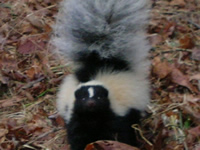SKUNKS
[audio:skunks.mp3|titles=Skunks Sounds]
Peak Nuisance Period: February and March, when they’re mating. In May and June, they are actively grubbing in lawns. This picks up again in late July, continuing through mid–October
Common Nuisance Situations:
- Seeking a sheltered place to raise their young. They may den under porches, decks, foundations, garages, barns, or sheds.
- Stinking up the place. Skunks can be very smelly, especially from the mating season through the whelping season, if the female fights off a male. If the smell seems to come and go, and is more noticeable at dawn or dusk, or with a shift in wind direction, or seems to be coming from an area with evergreen trees, it might be the odor of a great horned owl. These owls commonly eat skunks.
- Defending themselves. Skunks are a mild-mannered, slow-moving, mind-your-own-business kind of animal. If provoked, they may spray people or pets. Their spray can reach up to 16 feet. Skunks can spray once they’re 2–4 weeks old. They can spray up to six times in a row, then need a day to “recharge.”
- They’ll fall into window wells while searching for insects and toads, and then become trapped.
- Skunks dig in lawns for grubs. They’ll sometimes scratch beehives in search of honey and insects,or raid poultry houses for eggs and chickens (but that’s rare, and such damage is more likely the work of a raccoon).
- Disease risks: Rabies (they are a rabies vector species in New York), distemper.
Animal Characteristics
Description: There coat is thick, fluffy, mainly black with a large white nape patch that continues and becomes two stripes along sides of back, usuually reaching the tail (occasionally mostly white above). They typcially will have a narrow white forehead stripe. Their head is pointed having small ears and eyes. Their legs are short and their tail is long and very bushy. Skunks sleep deeply for up to 3 ½ months at a time but are not true hibernators. They’ll emerge periodically during warm spells and during the mating season. Skunks den alone, or in a group of 2–7 females and 1 male. They do not migrate.
Caution: If threatened it raises it’s tail, backs up and may stomp ground; may very quickly emit foulsmelling, sulphurous spray that travels to 16′, stings eyes of predators, pets, humans.
Diet: Eats insects, rodents, bird and turtle eggs, fruit, roadkills, garbage.
Habitat: Widespread, from coastal habitats to mature woodlands and small woodlots. Prefers open fields, lawns, and agricultural areas with areas of mixed shrubs and forest edges, near buildings, barns, or porches.
Breeding: Breed from late February to March. Gestation takes about 62 to 75 days. They give birth May through June. Typical litter size is 4 to 7 skunks.
Mythbusters:
- A skunk that’s active during the day isn’t necessarily rabid. It may be a healthy female that’s feeding more often than usual, because of the demands of her young.
- Adult skunks are not trigger-happy but “teenaged” skunks may be. Very young skunks squirt small amounts of fluid as they walk because they’re not yet mature enough to have control of the “spray muscles.” If you can “talk skunk,” you can usually tell if an adult skunk intends to spray .
- Grubbing by skunks is sometimes blamed on other animals because there’s no skunk smell.Skunks spray in defense.
